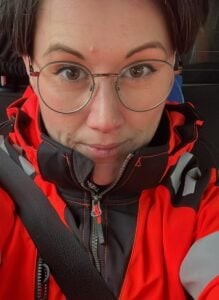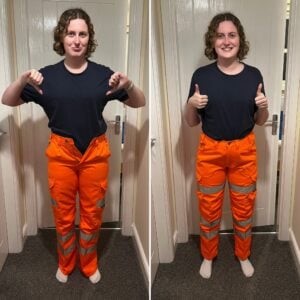'It took six years before I realised PPE for women was available': Katy Robinson on making a difference

As a woman who's been working in the construction industry for over half a decade, it's no surprise that it took six years for me to receive PPE, designed for women. It also took six years for me to discover that PPE designed for women was even available on the market! Katy Robinson is spearheading a PPE campaign targeting the Yorkshire construction sector. Here, she explains its origin, the progress made, and why there is still much to do.

Katy comparing the fit of men’s and women’s high-visibility trousers
As a woman who’s been working in the construction industry for over half a decade, it’s no surprise that it took six years for me to receive PPE, designed for women. It also took six years for me to discover that PPE designed for women was even available on the market!
Our campaign focus is not because employers don’t provide PPE to women – that would be rather unethical if you ask me! But instead, the focus is because 59.6% of women have to wear PPE that is designed for men which impacts self-confidence and perceived professionalism and actually enhances risk.
Teased on site
One barrier I unknowingly faced throughout my career was ill-fitting PPE. I’ve been teased on sites for wearing ‘clown boots’ – which were in my size, but were ridiculously wide and uncomfortable – I purchased foam insoles to avoid the constant blisters thinking this was completely normal! The teasing never bothered me, but it did make me question the way that others perceived me.
Another example was having to wear men’s/unisex trousers, which caused discomfort and pain. Despite them being the correct length, they were certainly not the right size for women, resulting in baggy calves that could get snagged on anything, and a tight waistband that wouldn’t button or zip up without causing discomfort. I couldn’t even sit down comfortably!
“I just assumed that no one would take me seriously…”
Whether it be the stigma around women speaking up, or the stereotype that women in construction are tough, I didn’t feel comfortable speaking out about my discomfort, especially as I was a young female apprentice, I just assumed that no one would take me seriously.
After a few more years in the industry, I changed employers and went down the Project Management route, and in 2023 I became the Campaign Manager of our PPE campaign, as a voluntary role alongside my full-time job as a Senior Project Manager at a local authority.
Raising awareness
The idea was sparked from a call with Bold as Brass founder and SHP contributor Katherine Evans (pictured), eventually, we all wanted to see what the National Association of Women in Construction (NAWIC) Yorkshire could do to push and elevate an existing PPE campaign that had been circulating in the industry for several years.
As previously mentioned, I didn’t know women’s PPE was available until this conversation. I decided to do some digging within my own organisation and look into its own provision for women’s PPE. I wasn’t entirely shocked when I discovered the catalogue did not offer anything women’s specific, but strangely enough, did offer children’s PPE. I raised the issue internally and it was quickly resolved, but it did highlight for me that one of the main issues here is that managers and procurement departments didn’t have any awareness of the issue women suffer with.
We decided to target our campaign around awareness. The first hurdle was deciding how to flag this to a large group of construction companies. Our social media campaign could only go so far, we needed to start approaching industry-leading organisations and stakeholders to join the movement.
“Our first move was to contact every single framework and ask for their support…”
Public sector contracts are responsible for a significant chunk of construction work in the UK and are controlled by public sector frameworks. Our first move was to contact every single one of these frameworks and ask for their support. YORhub was the first framework to join the campaign, inviting me to present in front of their contractors, but also elevating the campaign themselves to the National Association of Construction Frameworks (NACF).
The next step was to influence SMEs, which account for 60% of employment in the construction industry, and are less likely to have provision for women’s PPE compared to larger organisations. The idea actually came to me in a traffic jam, as I noticed a trade van in front with a list of accreditations across its rear.
We then targeted health and safety accreditations, appreciating that changing assessments and accreditation criteria can be difficult, but that they could raise awareness of it, as a minimum. To our surprise, several accreditations agreed to add the provision for women’s PPE into their assessments, with implementations scheduled for 2024.
Pioneers
As a final note, the construction industry is typically reactive, often not making changes until the worst scenario happens and lessons are learnt the hard way. We have the opportunity to get ahead of this, we have the opportunity to make a difference before a woman dies on-site from ill-fitting PPE.
Ill-fitting PPE is an issue for women that is felt across both male-dominated, and female-dominated industries. The construction sector can be a pioneer in this and be the first industry to make a solid effort to enforce the provision of women’s PPE.



